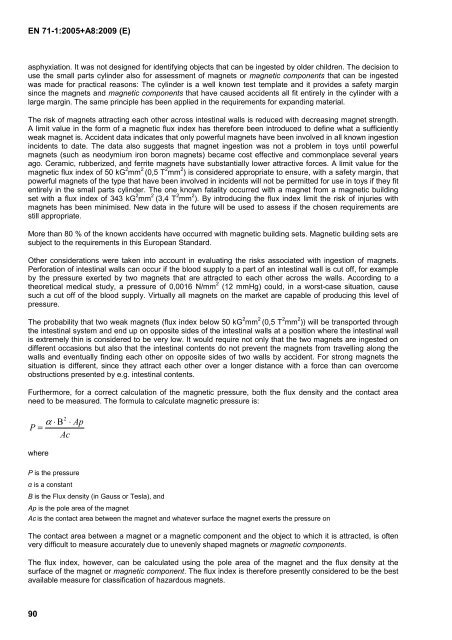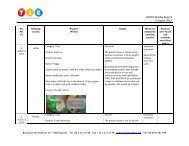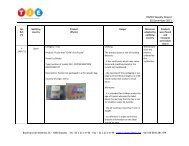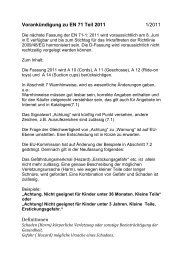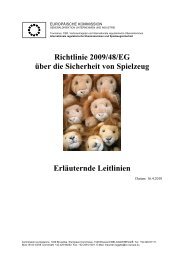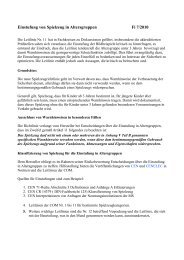You also want an ePaper? Increase the reach of your titles
YUMPU automatically turns print PDFs into web optimized ePapers that Google loves.
<strong>EN</strong> <strong>71</strong>-1:<strong>2005+</strong><strong>A8</strong>:2009 (E)<br />
asphyxiation. It was not designed for identifying objects that can be ingested by older children. The decision to<br />
use the small parts cylinder also for assessment of magnets or magnetic components that can be ingested<br />
was made for practical reasons: The cylinder is a well known test template and it provides a safety margin<br />
since the magnets and magnetic components that have caused accidents all fit entirely in the cylinder with a<br />
large margin. The same principle has been applied in the requirements for expanding material.<br />
The risk of magnets attracting each other across intestinal walls is reduced with decreasing magnet strength.<br />
A limit value in the form of a magnetic flux index has therefore been introduced to define what a sufficiently<br />
weak magnet is. Accident data indicates that only powerful magnets have been involved in all known ingestion<br />
incidents to date. The data also suggests that magnet ingestion was not a problem in toys until powerful<br />
magnets (such as neodymium iron boron magnets) became cost effective and commonplace several years<br />
ago. Ceramic, rubberized, and ferrite magnets have substantially lower attractive forces. A limit value for the<br />
magnetic flux index of 50 kG 2 mm 2 (0,5 T 2 mm 2 ) is considered appropriate to ensure, with a safety margin, that<br />
powerful magnets of the type that have been involved in incidents will not be permitted for use in toys if they fit<br />
entirely in the small parts cylinder. The one known fatality occurred with a magnet from a magnetic building<br />
set with a flux index of 343 kG 2 mm 2 (3,4 T 2 mm 2 ). By introducing the flux index limit the risk of injuries with<br />
magnets has been minimised. New data in the future will be used to assess if the chosen requirements are<br />
still appropriate.<br />
More than 80 % of the known accidents have occurred with magnetic building sets. Magnetic building sets are<br />
subject to the requirements in this European Standard.<br />
Other considerations were taken into account in evaluating the risks associated with ingestion of magnets.<br />
Perforation of intestinal walls can occur if the blood supply to a part of an intestinal wall is cut off, for example<br />
by the pressure exerted by two magnets that are attracted to each other across the walls. According to a<br />
theoretical medical study, a pressure of 0,0016 N/mm 2 (12 mmHg) could, in a worst-case situation, cause<br />
such a cut off of the blood supply. Virtually all magnets on the market are capable of producing this level of<br />
pressure.<br />
The probability that two weak magnets (flux index below 50 kG 2 mm 2 (0,5 T 2 mm 2 )) will be transported through<br />
the intestinal system and end up on opposite sides of the intestinal walls at a position where the intestinal wall<br />
is extremely thin is considered to be very low. It would require not only that the two magnets are ingested on<br />
different occasions but also that the intestinal contents do not prevent the magnets from travelling along the<br />
walls and eventually finding each other on opposite sides of two walls by accident. For strong magnets the<br />
situation is different, since they attract each other over a longer distance with a force than can overcome<br />
obstructions presented by e.g. intestinal contents.<br />
Furthermore, for a correct calculation of the magnetic pressure, both the flux density and the contact area<br />
need to be measured. The formula to calculate magnetic pressure is:<br />
2<br />
α ⋅ B ⋅ Ap<br />
P =<br />
Ac<br />
where<br />
P is the pressure<br />
α is a constant<br />
B is the Flux density (in Gauss or Tesla), and<br />
Ap is the pole area of the magnet<br />
Ac is the contact area between the magnet and whatever surface the magnet exerts the pressure on<br />
The contact area between a magnet or a magnetic component and the object to which it is attracted, is often<br />
very difficult to measure accurately due to unevenly shaped magnets or magnetic components.<br />
The flux index, however, can be calculated using the pole area of the magnet and the flux density at the<br />
surface of the magnet or magnetic component. The flux index is therefore presently considered to be the best<br />
available measure for classification of hazardous magnets.<br />
90


